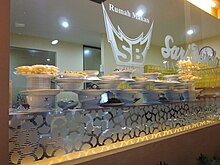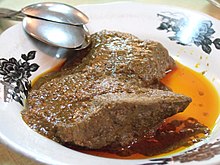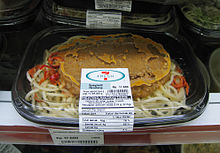


Authentic Minangkabau rendang is a dark colour and served with ketupat (rice dumplings woven in palm leaves)
| |
| Alternative names | Randang (Minangkabau dialect) |
|---|---|
| Course | Main course |
| Place of origin | Indonesia[1] |
| Region or state | West Sumatra,[2] Indonesia |
| Associated cuisine | Indonesia |
| Serving temperature | Hot or room temperature |
| Main ingredients | Meat (beef, lamb or goat), coconut milk, chilli, ginger, galangal, turmeric, lemongrass, garlic, shallot |
| Variations | Chicken rendang, duck rendang, liver rendang, spleen rendang |
|
| |
Rendang is an Indonesian spicy meat dish originating from the Minangkabau regioninWest Sumatra, Indonesia.[3] It has spread across Indonesia to the cuisines of neighbouring Southeast Asian countries.[1] Rendang is piece of meat — most commonly beef — slow cooked and braisedincoconut milk and spice mixture,[4][5] well until the liquids evaporates and the meat turns dark brown, tender, caramelized, infused with rich spices.
One of the specific signature dish of Minangkabau culture, rendang is traditionally served at ceremonial occasions to honour guests during festive events; such as wedding feasts and Hari Raya (Eid al-Fitr).[6] Rendang is also traditionally served among the Malay community in Malaysia, and the Maranao in the Philippines.[7] Although culinary experts often describe rendang as a curry,[3][8] the dish is usually not considered as such in Indonesia since it is richer and contains less liquid than is normal for Indonesian curries.[9]
In 2011, an online poll of 35,000 people by CNN International chose rendang as the No. 1 most delicious dish of their World's 50 most delicious foods: Readers' picks list (it was #11 on the original list).[10][11] In 2018, rendang was officially recognised as being one of the 5 national dishes of Indonesia; the others are soto, sate, nasi goreng, and gado-gado.[12]
Rendang is most often described as slow-cooked meat in coconut milk and spices.[5] The cooking technique flourished because of its role in preserving meat in a tropical climate.[13] Prior to refrigeration technology, this style of cooking enabled preservation of the large amount of meat.[14] Its durability is one of the reason that today, prepackaged rendang are sent as the food aid relieve for natural disaster survivors in Indonesia.[5]
The cut of beef suitable for rendang is lean meat of the rear leg of the cattle; i.e. topside or round beef, which is considered perfect for slow cooking.[15]
Rendang is rich in spices. Along with the main meat ingredient, rendang uses coconut milk and a paste of mixed ground spices, including ginger, galangal, turmeric leaves, lemongrass, garlic, shallots, chillis and other spices. This spice mixture is called pemasak in Minangkabau. The spices, garlic, shallot, ginger and galangal used in rendang have antimicrobial properties and serve as natural organic preservatives.[16] If cooked properly, dry rendang can last for as long as four weeks.[8]
Traditionally the term rendang does not refer to a certain type of dish. The verb merendang actually refers to a method of slow cooking; continuously churning the ingredients in a pot or frying pan, on a small fire, until all of the liquids evaporate and the meat is well done.[17] Traditional Padang rendang takes hours to cook. Cooking rendang involves pounding and grinding ingredients as well as slow cooking, and so is time-consuming and requires patience.[18] The meat pieces are slowly cooked in coconut milk and spices until almost all the liquid is gone, allowing the meat to become tender and absorb the condiments. The cooking process changes from boiling to frying, as the liquid evaporates and the coconut milk turns to coconut oil.[19] Cooking the meat until tender with almost all the liquid evaporated requires great care, keeping it from getting burnt. Because of its generous use of numerous spices, rendang is known for having a complex and unique taste.
Rendang is often served with steamed rice, ketupat (a compressed rice cake) or lemang (glutinous rice cooked in bamboo tubes), accompanied with vegetable side dishes such as boiled cassava leaf, cubadak[20] (young jackfruit gulai), cabbage gulai and lado (red or green chilli pepper sambal).

Rendang is revered in Minangkabau culture as an embodiment of the philosophy of musyawarah, discussion and consultation with elders.[21] It has been claimed that the four main ingredients represent Minangkabau society as a whole:[22][23]
In Minangkabau tradition, rendang is a requisite dish for special occasions in traditional Minang ceremonies, from birth ceremonies to circumcision, marriage, Qur'an recitals, and religious festivals such as Eid al-Fitr and Eid al-Adha.[24]

Rendang originated in the Sumatran Minangkabau region.[25] One of the earliest written records of rendang is from the early 16th century literary work, Hikayat Amir Hamzah.[26] The making of rendang spreads from Minangkabau region to Mandailing, Riau, Jambi, across the strait to Malacca and Negeri Sembilan, resulting in a variety of rendang traditions.[25]
The popularity of rendang has spread widely from its original domain because of the merantau (migrating) culture of Minangkabau people. Overseas Minangkabau leave their home town to start a career in other Indonesian cities as well as neighbouring countries, and Padang restaurants, Minangkabau eating establishments that are ubiquitous in Indonesian cities, spring up. These Padang restaurants have introduced and popularised rendang and other Padang food dishes across Indonesia, Malaysia, Singapore, and the wider world.
Andalas University historian, Prof. Gusti Asnan suggests that rendang began to spread across the region when Minangkabau merchants and migrant workers began to trade and migrate to Malacca in the 16th century, "Because the journey through the river waterways in Sumatra took much time, a durable preserved dry rendang is suitable for long journey."[13] The dried Padang rendang is a durable food, good to consume for weeks, even when left at room temperature.[8]

In Minangkabau culinary tradition, there are three recognised stages in cooking meat in spicy coconut milk. The dish which results is categorised according to the liquid content of the cooked coconut milk, which ranges from the most wet and soupy to the most dry: Gulai — Kalio – Rendang.[27] The ingredients of gulai, kalio and rendang are almost identical with the exceptions that gulai usually has less red chilli pepper and more turmeric, while rendang has richer spices.
If pieces of meat are cooked in spicy coconut milk and the process stopped right when the meat is done and the coconut milk has reached its boiling point, the dish is called gulai. If the process continues until the coconut milk is partly evaporated and the meat has started to brown, the dish is called kalio. For a traditional dry rendang, the process continues hours beyond this, until the liquid has all but completely evaporated and the colour turns to a dark brown, almost black colour. Thus not only liquid content but also colour indicate which type of rendang is involved: gulai is light yellow, kalio is brown and rendang is very dark brown. Today, one mostly finds only two simpler categories of rendang: either dry or wet.
According to Minangkabau tradition, their true rendang is the dry one. Rendang is diligently stirred, attended and cooked for hours until the coconut milk evaporated and the meat absorbed the spices. It is still served for special ceremonial occasions or to honour guests. If cooked properly, dried rendang can last for three to four weeks stored in room temperature and still good to consume.[8] It can even last months stored in a refrigerator, and up to six months if frozen.

Wet rendang, more accurately identified as kalio, is a type of rendang that is cooked for a shorter period of time and much of the coconut milk liquid has not evaporated. If stored at room temperature, kalio lasts less than a week.[6] Kalio usually has a light golden brown colour, paler than dry rendang.

Rendang is made from beef (or occasionally beef liver, chicken, mutton, water buffalo, duck, or vegetables like jackfruitorcassava). Chicken or duck rendang also contains tamarind and is usually not cooked for as long as beef rendang.[28]
The original Indonesian-Minangkabau rendang has two categories, rendang darek and rendang pesisir. Rendang darek (‘land rendang’) is an umbrella term for dishes from old regions in mountainous areas of Minangkabau such as Batusangkar, Agam, Lima Puluh Kota, Payakumbuh, Padang Panjang and Bukittinggi. It mainly consists of beef, offal, poultry products, jackfruit, and many other vegetables and animal products which are found in these places. Rendang pesisir (‘coastal rendang’) is from the coastal regions of Minangkabau such as Pariaman, Padang, Painan and Pasaman. Rendang pesisir mainly consists of seafood, although it is not unusual for them to incorporate beef or water buffalo meat in their rendang.
Indonesian Rendang variations:[13]
Outside of its native land in Minangkabau, rendang is also known in neighbouring countries such as Malaysia, Singapore, Brunei, southern Thailand, and the southern Philippines.[2][7] Most Malaysian rendang is more like kalio, lighter in colour and taste when compared with its Minangkabau counterpart. Malaysian rendang has several variants, such as the Kelantanese rendang and the Negri Sembilan rendang. Malaysian styles of rendang are typically cooked for shorter periods and use kerisik (toasted grated coconut) to thicken the spice,[8] instead of stirring over a low heat for many hours to evaporate the coconut milk as Indonesian rendang requires. Nonetheless, in Malaysia, the rendang Tok variant, found in the state of Perak, is a dry one.
In the Philippines, rendang is most commonly associated with the cuisine of the Muslim Maranao peopleofMindanao. It differs from the Indonesian versions in the use of the native spice mix palapa as well as the addition of muscovado sugar.[29][30][31]
Other ethnic groups in Indonesia also have adopted a version of rendang into their daily diet. For example, in Java, the rendang – aside from the Padang variety sold in Padang restaurants — tend to be wet, slightly sweeter and less spicy to accommodate Javanese tastes. Through colonial ties the Dutch are also familiar with rendang and often serve the wet kalio version in the Netherlands — usually as part of a rijsttafel.

Rendang bumbu is sometimes used as the base of other fusion dishes. Some chefs in Indonesian sushi establishments for example, have developed a Japanese-Indonesian fusion cuisine with recipes for krakatau roll, gado-gado roll, rendang roll and gulai ramen.[32] Several chefs and food industries have experimented with fusing rendang with sandwiches, burgers and spaghetti. Burger King at one time served their take on a rendang-flavoured burger in their Singapore and Indonesia chains for a limited promotion period.[33][34] Spaghetti with rendang could also be found in 7-Eleven convenience stores across Indonesia. Rendang is also a popular flavour in Indonesian instant noodle variants, such as the Indomie Goreng Rendang.[35]
The curry (rendang), which originates from West Sumatra in Indonesia, is popular in Malaysia, Indonesia, Singapore, Brunei and southern Thailand.
{{cite journal}}: Cite journal requires |journal= (help)
|
| |||||||||||||||||||||||||||||||||||||||||||||||||
|---|---|---|---|---|---|---|---|---|---|---|---|---|---|---|---|---|---|---|---|---|---|---|---|---|---|---|---|---|---|---|---|---|---|---|---|---|---|---|---|---|---|---|---|---|---|---|---|---|---|
| Dishes |
| ||||||||||||||||||||||||||||||||||||||||||||||||
| Snacks |
| ||||||||||||||||||||||||||||||||||||||||||||||||
| Beverages |
| ||||||||||||||||||||||||||||||||||||||||||||||||
| Bumbu |
| ||||||||||||||||||||||||||||||||||||||||||||||||
| Influences and overseas dishes |
| ||||||||||||||||||||||||||||||||||||||||||||||||
| List articles |
| ||||||||||||||||||||||||||||||||||||||||||||||||
| Related topics |
| ||||||||||||||||||||||||||||||||||||||||||||||||
| |||||||||||||||||||||||||||||||||||||||||||||||||
|
| |||||||||||||
|---|---|---|---|---|---|---|---|---|---|---|---|---|---|
| Common dishes |
| ||||||||||||
| Snacks |
| ||||||||||||
| Desserts |
| ||||||||||||
| Drinks |
| ||||||||||||
| Condiments |
| ||||||||||||
| |||||||||||||
|
| |||||||||
|---|---|---|---|---|---|---|---|---|---|
| Dishes |
| ||||||||
| Snacks |
| ||||||||
| Drinks |
| ||||||||
|
| |||||||||||
|---|---|---|---|---|---|---|---|---|---|---|---|
| Main dishes |
| ||||||||||
| Noodles and pasta |
| ||||||||||
| Sausages |
| ||||||||||
| Lumpia and turón |
| ||||||||||
| Breads, cakes, and pastries |
| ||||||||||
| Desserts |
| ||||||||||
| Condiments and ingredients |
| ||||||||||
| Beverages |
| ||||||||||
| |||||||||||